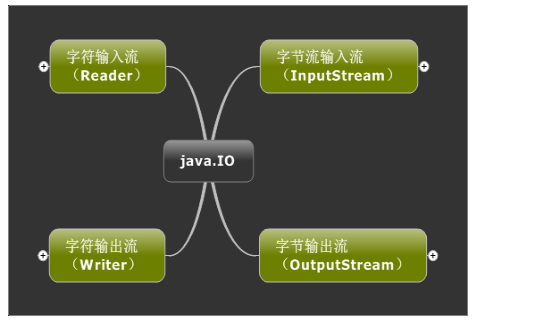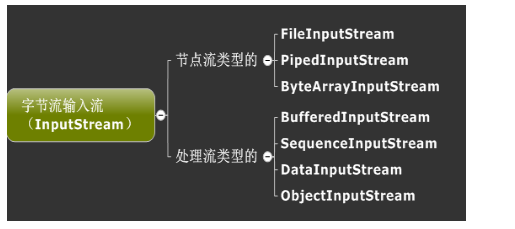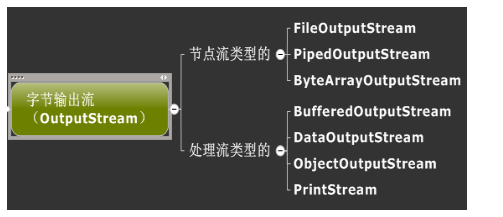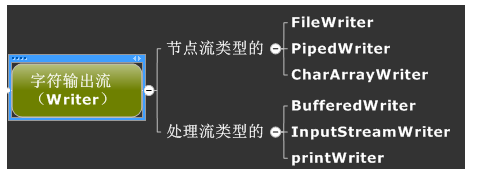Java IO流
Java中的流,可以從不同的角度進行分類。
按照數據流的方向不同可以分為:輸入流和輸出流。
按照處理數據單位不同可以分為:字節流和字符流。
按照實現功能不同可以分為:節點流和處理流。
輸出流:

輸入流:

因此輸入和輸出都是從程序的角度來說的。
字節流:一次讀入或讀出是8位二進制。
字符流:一次讀入或讀出是16位二進制。
字節流和字符流的原理是相同的,只不過處理的單位不同而已。後綴是Stream是字節流,而後綴是Reader,Writer是字符流。
節點流:直接與數據源相連,讀入或讀出。

直接使用節點流,讀寫不方便,為了更快的讀寫文件,才有了處理流。
處理流:與節點流一塊使用,在節點流的基礎上,再套接一層,套接在節點流上的就是處理流。

Jdk提供的流繼承了四大類:InputStream(字節輸入流),OutputStream(字節輸出流),Reader(字符輸入流),Writer(字符輸出流)。
以下是java中io中常用的流。

字節輸入流:

字節輸出流:

字符輸入流:

字符輸出流:

簡單介紹其上圖:
對文件進行操作:FileInputStream(字節輸入流),FileOutputStream(字節輸出流),FileReader(字符輸入流),FileWriter(字符輸出流)
FileReader、FileWriter 可以實現文本文件的復制, 對於非文本文件(視頻文件、音頻文件、圖片),只能使用字節流!
例子:
// 字節流實現文件復制的方法
public void copyFile(String src, String dest) {
// 1.提供讀入、寫出的文件
File file1 = new File(src);
File file2 = new File(dest);
// 2.提供相應的流
FileInputStream fis = null;
FileOutputStream fos = null;
try {
fis = new FileInputStream(file1);
fos = new FileOutputStream(file2);
// 3.每次讀取的字節數
byte[] b = new byte[20];
int len;
while ((len = fis.read(b)) != -1) {
// fos.write(b);//錯誤的寫法兩種: fos.write(b,0,b.length);
fos.write(b, 0, len);
}
} catch (Exception e) {
e.printStackTrace();
} finally {
if (fos != null) {
try {
fos.close();
} catch (IOException e) {
e.printStackTrace();
}
}
if (fis != null) {
try {
fis.close();
} catch (IOException e) {
e.printStackTrace();
}
}
}
}// 字符流實現文件復制的方法
public void copyFile(String src, String dest) {
//1.輸入流對應的文件src一定要存在,否則拋異常。輸出流對應的文件dest可以不存在,執行過程中會自動創建
FileReader fr = null;
FileWriter fw = null;
// 1.提供讀入、寫出的文件
File file1 = new File(src);
File file2 = new File(dest);
try {
fr= new FileReader(file1);
fw = new FileWriter(file2);
// 3.每次讀取的字符數
char[] c = new char[24];
int len;
while ((len = fr.read(c)) != -1) {
// fos.write(c);//錯誤的寫法兩種: fos.write(c,0,c.length);
fos.write(c, 0, len);
}
} catch (Exception e) {
e.printStackTrace();
} finally{
if(fw != null){
try {
fw.close();
} catch (IOException e) {
// TODO Auto-generated catch block
e.printStackTrace();
}
}
if(fr != null){
try {
fr.close();
} catch (IOException e) {
// TODO Auto-generated catch block
e.printStackTrace();
}
}
}
}public void testCopyFile(){
long start = System.currentTimeMillis();
String src = "C:\\Users\\shkstart\\Desktop\\dbcp.txt";
String dest = "C:\\Users\\shkstart\\Desktop\\dbcp1.txt";
copyFile(src,dest);
long end = System.currentTimeMillis();
System.out.println("花費的時間為:" + (end - start));//3198
}對管道進行操作:PipedInputStream(字節輸入流),PipedOutStream(字節輸出流),PipedReader(字符輸入流),PipedWriter(字符輸出流)
PipedInputStream的一個實例要和PipedOutputStream的一個實例共同使用,共同完成管道的讀取寫入操作。主要用於線程操作。
字節/字符數組:ByteArrayInputStream,ByteArrayOutputStream,CharArrayReader,
CharArrayWriter是在內存中開辟了一個字節或字符數組。
Buffered緩沖流:BufferedInputStream,BufferedOutputStream (flush()刷新緩沖區),BufferedReader (readLine()讀取一行),BufferedWriter (flush()刷新緩沖區) ,是帶緩沖區的處理流,緩沖區的作用的主要目的是:避免每次和硬盤打交道,提高數據訪問的效率。
例子:
//使用緩沖流實現文件的復制的方法
public void copyFile(String src,String dest){
BufferedInputStream bis = null;
BufferedOutputStream bos = null;
try {
//1.提供讀入、寫出的文件
File file1 = new File(src);
File file2 = new File(dest);
//2.想創建相應的節點流:FileInputStream、FileOutputStream
FileInputStream fis = new FileInputStream(file1);
FileOutputStream fos = new FileOutputStream(file2);
//3.將創建的節點流的對象作為形參傳遞給緩沖流的構造器中
bis = new BufferedInputStream(fis);
bos = new BufferedOutputStream(fos);
//4.具體的實現文件復制的操作
byte[] b = new byte[1024];
int len;
while((len = bis.read(b)) != -1){
bos.write(b, 0, len);
bos.flush();
}
}catch (IOException e) {
// TODO Auto-generated catch block
e.printStackTrace();
}finally{
//5.關閉相應的流
if(bos != null){
try {
bos.close();
} catch (IOException e) {
// TODO Auto-generated catch block
e.printStackTrace();
}
}
if(bis != null){
try {
bis.close();
} catch (IOException e) {
// TODO Auto-generated catch block
e.printStackTrace();
}
}
}
}轉化流:InputStreamReader/OutputStreamWriter,把字節轉化成字符。
/*
* 如何實現字節流與字符流之間的轉換:
* 轉換流:InputStreamReader OutputStreamWriter
* 編碼:字符串 --->字節數組
* 解碼:字節數組--->字符串
*/
@Test
public void test1(){
BufferedReader br = null;
BufferedWriter bw = null;
try {
//解碼
File file = new File("dbcp.txt");
FileInputStream fis = new FileInputStream(file);
InputStreamReader isr = new InputStreamReader(fis, "UTF-8");
br = new BufferedReader(isr);
//編碼
File file1 = new File("dbcp4.txt");
FileOutputStream fos = new FileOutputStream(file1);
OutputStreamWriter osw = new OutputStreamWriter(fos, "UTF-8");
bw = new BufferedWriter(osw);
String str;
while((str = br.readLine()) != null){
bw.write(str);
bw.newLine();
bw.flush();
}
}catch (IOException e) {
// TODO Auto-generated catch block
e.printStackTrace();
}finally{
if(bw != null){
try {
bw.close();
} catch (IOException e) {
// TODO Auto-generated catch block
e.printStackTrace();
}
}
if(br != null){
try {
br.close();
} catch (IOException e) {
// TODO Auto-generated catch block
e.printStackTrace();
}
}
}
}數據流:DataInputStream,DataOutputStream。
因為平時若是我們輸出一個8個字節的long類型或4個字節的float類型,那怎麽辦呢?可以一個字節一個字節輸出,也可以把轉換成字符串輸出,但是這樣轉換費時間,若是直接輸出該多好啊,因此這個數據流就解決了我們輸出數據類型的困難。數據流可以直接輸出float類型或long類型,提高了數據讀寫的效率。
打印流:printStream,printWriter,一般是打印到控制臺,可以進行控制打印的地方。
對象流:ObjectInputStream,ObjectOutputStream,把封裝的對象直接輸出,而不是一個個在轉換成字符串再輸出。
序列化流:SequenceInputStream。
對象序列化:把對象直接轉換成二進制,寫入介質中。
使用對象流需要實現Serializable接口,否則會報錯。而若用transient關鍵字修飾成員變量,不寫入該成員變量,若是引用類型的成員變量為null,值類型的成員變量為0.
參考:http://blog.csdn.net/yuebinghaoyuan/article/details/7388059/
本文出自 “ciyo技術分享” 博客,請務必保留此出處http://ciyorecord.blog.51cto.com/6010867/1936503
Java IO流
